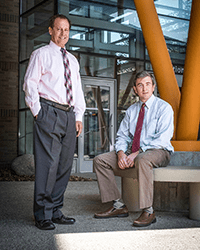Daily Hydroxyurea Pill Safely Lowers Sickle Cell Burden Among African Children
|
Top Breakthrough Discovery | Published December 2018 in The New England Journal of Medicine |

Russell Ware, MD, PhD, and Patrick McGann, MD
“From Nothing to Gangbusters.” That’s how the New York Times described the impact of the REACH study, which demonstrated the far-reaching, life-saving potential of a relatively old medication called hydroxyurea.
The study’s lead researchers were Russell Ware, MD, PhD, from Cincinnati Children’s, and Leon Tshilolo, MD, PhD, at the Centre Hospitalier Monkole in the Democratic Republic of the Congo (DRC). Co-authors from Cincinnati Children’s also included Adam Lane, PhD, Susan Stuber, MA, Teresa Latham, MA, and Patrick McGann, MD.
The REACH study team treated 606 children, ages 1 to 10, from Angola, Uganda, Keny,a and the DRC. Participants received one dose each day and were tracked for several years, with many receiving gradually escalated doses.
To conclude that the medication was “safe” would be a vast understatement. Toxicities were few and the benefits were rapidly achieved.
“We have used hydroxyurea successfully for many years in the United States, so bringing this treatment to sub-Saharan Africa, which has the largest global burden of disease, was the crucial next step,” Ware says. “Proving the feasibility, safety, and benefits of hydroxyurea in Africa will be transformative for millions of affected children.”
Encouraging results for an affordable treatment
“The importance of this effect should be evident for sub-Saharan Africa, where Plasmodium falciparum malaria is a major killer of children.”
Sickle cell disease affects millions of people worldwide, with 75 percent of the disease’s burden concentrated in sub-Saharan Africa. There, 50 to 90 percent of infants with sickle cell die before the age of 5, according to previous research led by Ware and colleagues. They also reported that efforts to help have stagnated because so many affected people lack access to basic diagnostics and clinical care.
In more developed nations, early diagnosis, blood transfusions, increasing use of hydroxyurea, and other treatments allow most people with sickle cell to live well into adulthood. In many places in Africa, however, such options have been too expensive.
But hydroxyurea can cost 50 cents a pill, or less, Ware says. The drug works by significantly increasing both hemoglobin and fetal hemoglobin, which reduces sickling, anemia and other complications. Compared to untreated populations, the REACH study reported that hydroxyurea use reduced rates of sickle cell pain by 55 percent, infections by 38 percent, malaria by 51 percent, transfusions by 67 percent, and deaths by 70 percent. Side effects were minimal, with only about 5 percent of children needing a reduced dose due to lower white blood cell counts.
“Reductions in event rates over time were noted for all sickle cell–related clinical events, malaria, vaso-occlusive pain, transfusion, the acute chest syndrome, and death from any cause,” the co-authors wrote. “Our results indicate that a daily dose of approximately 20 mg per kilogram per day was reasonably effective and not associated with dose-limiting toxic effects.”
The reduction in malaria infections, and resulting reduction in loss of life, came as a surprise.
“This benefit was especially notable after 12 months of treatment, so it may reflect known inhibitory effects of fetal hemoglobin, more than direct effects by hydroxyurea, on parasite growth,” the co-authors state. “The importance of this effect should be evident for sub-Saharan Africa, where Plasmodium falciparum malaria is a major killer of children and is especially lethal in those with sickle cell anemia.”




